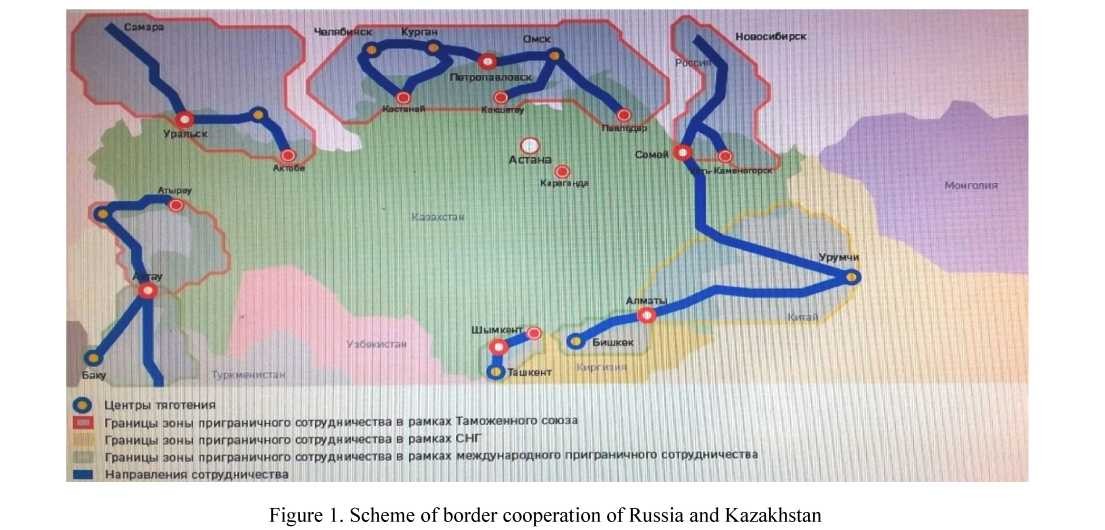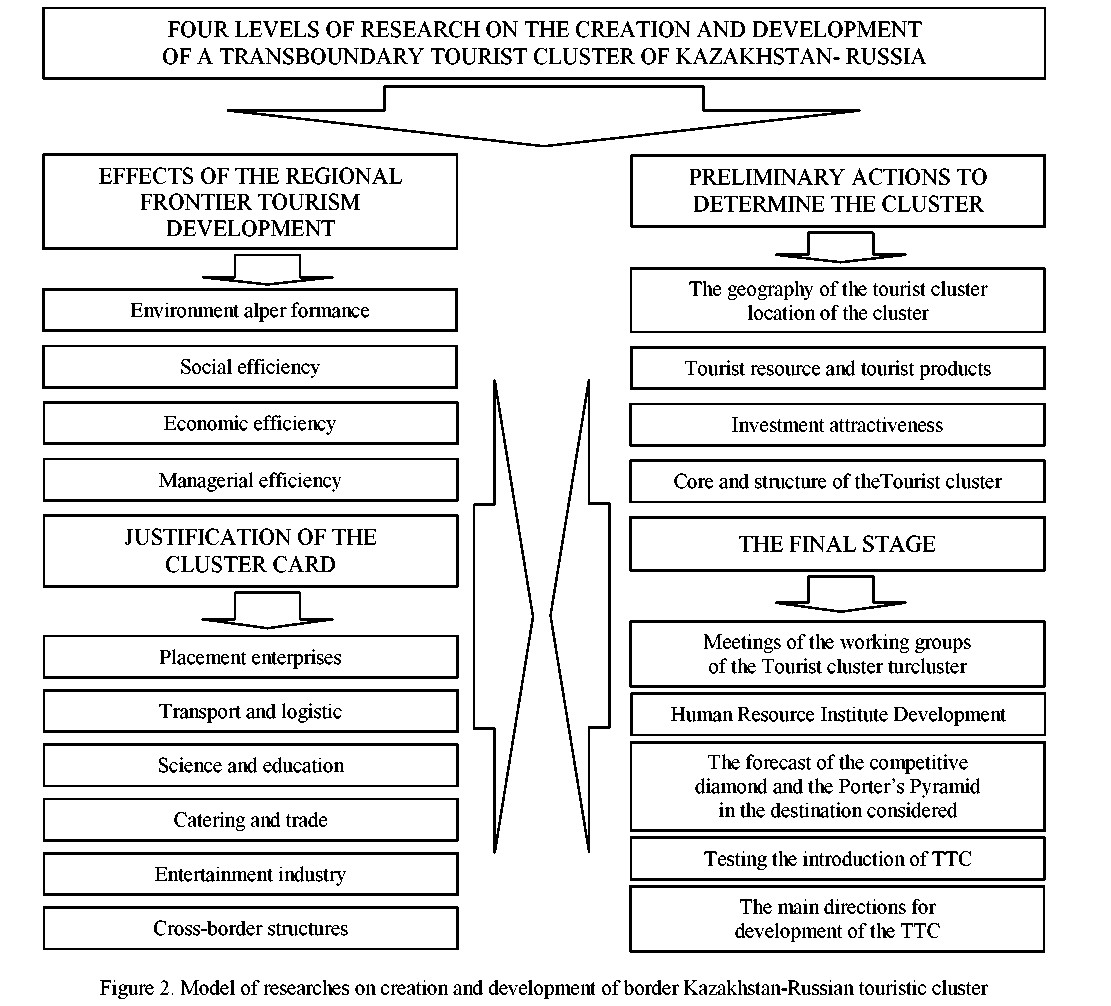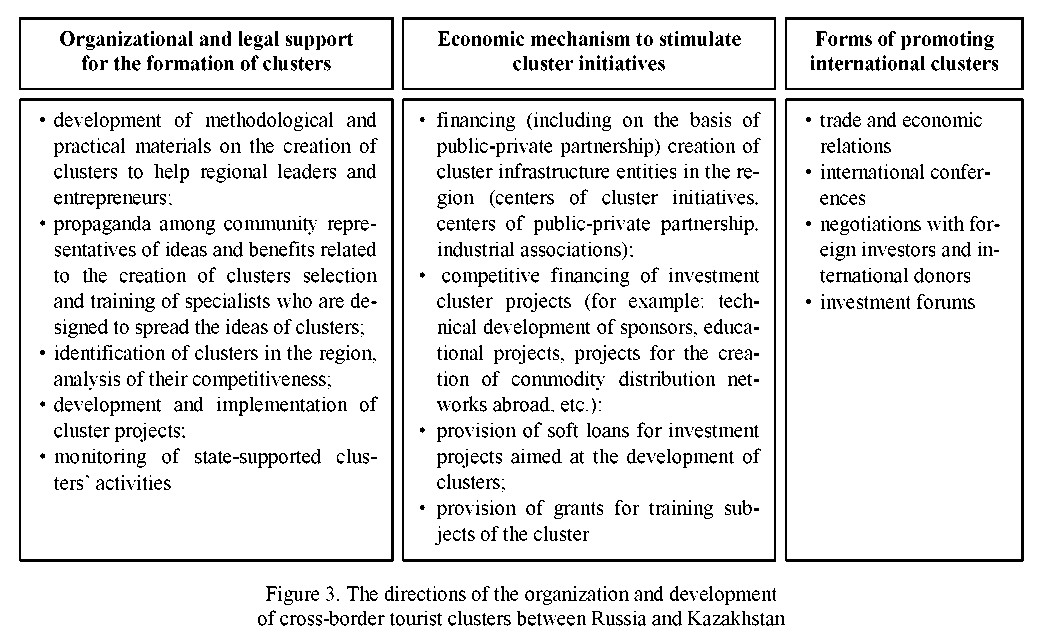The article is devoted to the problems of forming regional tourist clusters in the border areas of Kazakhstan and Russia, as well as methodologies for their creation and further development. The global tourism industry has significantly globalized and, with its rapid dynamics of development, has become a contender for the leading global industry. International tourism is currently one of the most dynamically developing branches of foreign economic activity. Tourism, both in Russia and in Kazakhstan, is recognized as one of the main priorities of the country's development, contributing to the diversification of the economy in the nonextractive sector. As one of the largest and fastest growing industries in the world, tourism has an impact on related industries like telecommunications and transport, construction and trade, and agriculture, contributing to the socio-economic development of regions. Kazakhstan, having a rich recreational potential, is characterized by a relatively weak level of tourism development, as evidenced by its insufficient share in the country's GDP. Socio-economic transformations observed in many CIS countries, their openness of border regions under the influence of integration processes in the world community, contribute to the strengthening of tourist mobility between neighboring countries. In the modern scientific community, recently, problems of the development of border regions of adjacent states and the prospects and directions for the development of crossborder cooperation are widely discussed. The usage of the «cluster-activate public strategy (CAPS)» as a network organization of economic interaction, adapted to any changes in the internal and external environment with the optimal distribution of growth coordinators, the conjugation of intellectual capital with the requirements of scientific and technological progress, is able to provide innovative breakthrough of the territory's economy, satisfactory resolution of the main tasks of any production process and ensuring its sustainability and reproduction. A model of Kazakhstan-Russian tourist cluster was presented in the context of four organizational levels of research of regional tourist destinations, as well as the main directions for the creation and development of tourist clusters in the border areas of Kazakhstan and Russia.
Relevance
In the conditions of an increasing globalization process, the development of individual territories becomes the basis for improving the competitiveness of the region and the state in a whole. In modern conditions of development of world economic relations and deepening of integration processes, programs of crossborder cooperation of regions are being actively developed and implemented.
The experience of developed and dynamically developing countries shows that the border regions have become zones of economic growth of these states. Border cities serve as centers of entrepreneurial activity and contribute to the successful integration of the whole country into the world economic system.
The states having the general borders, history and cultural heritage have also a number of the common problems connected with rational use of capacity of border territories and resources. Their successful decision depends on a number of objective and subjective factors among which readiness of the local and regional authorities for cooperation, effective cooperation for the purpose of the fullest use of their tourist and recreational potential and obtaining competitive advantages in comparison with other neighboring regions is prime. Identification of the prerequisites promoting mutually beneficial international cooperation and finding of ways of its development is necessary [1].
The cross-border region is the territory which covers adjacent boundary regions of the neighboring two or more countries, in which cross-border cooperation is implemented [2]. Cross-border cooperation also represents one of forms of cross-border interaction of authorities, economic entities, and the population of border areas. A basis of such cooperation is mutually advantageous trade and economic relations of border areas, and studying of structure and volumes of mutual trade, in turn — the most important component of the analysis of these relations. Experts allocate the following forms of cross-border cooperation. It can be both local border contacts, and also interaction based on contracts of cooperation between the separate organizations [3].
Materials and methodology of researches
The border-zone of Russia and Kazakhstan is presented by 12 Russian and 7 Kazakhstani regions which located along one of the most extended in the world, overland borders of two states — more than 7 thousand kilometers. Over 30 % of the population of Kazakhstan and 18,5 % of the population of Russia (in total more than 32 million people) live in the border areas of Russia and Kazakhstan. In Figure 1 the scheme of border cooperation of Russia and Kazakhstan is presented where the directions of cooperation and border of zones of border cooperation are separately highlighted.
The analysis of social and economic development of border areas of the Russian Federation and the Republic of Kazakhstan confirms weak investment attractiveness of border territories, the majority of the border cities is strongly removed from potential investors, the small-capacity regional markets and adverse investment climate because of poorly developed market infrastructure are the main characteristic of them; employment problems in the border cities because of duplication of economic activity; infrastructure dissociation in the border cities (public constructions and infrastructure, especially in health sector, educations and cultures, were initially created as national and, therefore, are focused only on internal investment) [4]. Tourism as a form of cross-border cooperation both in Russia, and in Kazakhstan is developed poorly and defined, as a rule with intraregional orientation. Spatial forms of the organization of tourism in the territory of the adjoining countries are the cross-border tourist regions including territories of two or more countries. In Kazakhstan, in general, the legislative base, which has determined legal forms of associations of the enterprises is adopted and there are prerequisites for formation of clusters in different spheres of economic activity.
From the beginning of processes of integration of Russia and Kazakhstan situation has significantly changed. Border territories began to carry out more and more contact, but not barrier functions. With the introduction in validity about EEU (Eurasian Economic Union), all conditions for further activation of the foreign trade relations between the states, including realization of huge potential of interregional cooperation are created. Today partnership in the sphere of industrial cooperation between Russia and Kazakhstan moves to a new level: considered the need of profound industrial cooperation. Now Kazakh Tourism plans to make reset in the tourist relations with the northern neighbor. So, in March, 2018, in Moscow the 25th International tourist MITT exhibition has taken place where Kazakh Tourism and Rostourism have signed the Memorandum of cooperation, here Kazakhstan has presented adventure tourism (from mountain skis to observation of pink flamingos).
One of large destinations, which borders here is North-Kazakhstan region. There are 21 travel agencies: seven tour operators and fourteen touristic agencies, where most of them RE located in the Imantau-Shalkar resort area of Ayyrtau district. In general, in tourist branch, in 2017, 668,5 million tenge are invested, includ-

ing 106 million in Ayyrtau district where the Imantau-Shalkar zone is located. Taxes and other payments from tourist activity in the budget in 2017 have made 140 million tenge that for 16,5 % more than 2016, the number of 1511 people occupied in branch [5].
According to the Concept of development of tourist branch of the Republic of Kazakhstan until 2023 Ayyrtau district is included in a cluster «Unity of the nature and nomadic culture». The comprehensive plan of development of the Imantau-Shalkar resort area for 2018-2021 is developed in 2 stages of development and in 4 directions as: providing engineering, transport, tourist infrastructure and safety of tourists, at the same time the required financing makes about 25,5 billion tenge. The road map of development of tourist branch of ITE (International Tourist Exhibition) for 2018-2020 has defined the most perspective for development of tourist branch areas such as: Shalakyn, Ayyrtau, Esil, Kyzylzharsky, Tayynshin and Petropavlovsk. The area borders in the North — Kurgan, Tyumen and Omsk regions of Russia, the territory of the area is located in the time zone of UTC +6 (Coordinated Universal Time). Perspective actions for development of tourism in the region are construction of the international scout camp for the countries of participants of SCO (Shanghai Cooperation Organisation); creation of an ethno-aul in Ayyrtau district, ecovillages in Kyzylzhar district, and also construction of the youth camp «Imantau-2018».
For the formation of the model of a cluster, the purposes and tasks are set, constructed its preliminary model, and made the analysis of each element of model. Regarding to this it becomes necessary to develop a technique where the main task is step-by-step designing of formation of a border touristic cluster. The main objective of a research is creation of Model of development of the tourist activity capable to provide sustainable social and economic development of cross-border territories of Kazakhstan. Formation of a border touristic cluster makes a start from the potential of appeal of the territory from the point of view of investment into tourist branch and assumes a combination of efforts of bodies of the state and municipal authority and business structures.
The model Kazakhstan-Russian touristic cluster is presented in a section of ranging of importance of development of regional tourism. Four levels of researches of the territory for creation of model of a touristic cluster are presented in Figure 2.
The result of researches is assessment of a possibility of creation of a touristic cluster in the border Kazakhstan-Russian territory.
The first level assumes consideration of effects of development of a tourist destination of creation of regional border tourism, which are subdivided by us into: the ecological, providing actions for rational environmental management; the social effects meaning employment rate of local population, prevention of migration, unemployment, high-quality increase in the standard of living of local community. The economic effects confirming growth of tax base, replenishment of the local and regional budget direct and indirect (effect of animation) influence of tourism on economy of border territories; administrative efficiency which will visually prove in inevitable increase in competitiveness of the region, increase in its image and status.
The second level provides preliminary actions for definition of a touristic cluster. This level includes definition of a tourist resource and tourist's products with further development of joint cross-border tourist routes and also cross-border tourist's packages. Here it is necessary to define cartographical borders of an estimated touristic cluster and its investment attractiveness. As a result at the exit we will be able to receive «skeleton» of structure of an estimated cluster and already to prove its Kernel.
The third level of researches on formation of a border touristic cluster will already allow us to hold events for drawing up the live card of participants of a touristic cluster, i.e. those potential businessmen who are ready to be a part of structure in the form of separate links which will really receive a value added chain from actually business activity. Recommendations about development of infrastructure in a cross-border zone and offers on simplification of visa formalities will be in parallel developed for entrance on the crossborder territory.
The fourth final level of creation and development of a tourist's cluster assumes meetings of the working groups of participants of a touristic cluster with universal involvement of Institute of human resources in the form of master classes, seminars and others. Interpretation of a competitive Rhombus and Porter's Pyramid on the studied destination as the main objective of the regional authorities promoting increase in competitiveness is creation of conditions for the most effective use of the available and potential factors of production. Here regions from the closed local markets turn into open economic spaces and those from regions which owing to any reasons can't be integrated into the system of global exchanges, promptly lose the main asset — the people who are washed away by migration processes to those areas where the labor is estimated
above and where there are best living conditions. The last actions will appear approbation of experimental model of a tourist's cluster at the exit and actions for further development of a touristic cluster.
Results and discussion
As appropriate, creation of the Kazakhstan-Russian cross-border touristic cluster intensifies crossborder tourism in boundary regions, will allow to solve separate infrastructure problems of tourism, will increase efficiency of activity of participants of a cluster, will improve quality and complexity of the tourist and accompanying services, will reduce transaction expenses and expenses on advertizing, will reduce unemployment. Its formation will promote increase in competitiveness of two states. The cluster will render assistance to development of business, the organization of new businesses within clusters and also realization of cooperation in the sphere of science and education.
The cluster will provide export growth in two countries (by means of implementation of joint programs of marketing and sales of products abroad), stirs up innovative investment activities as a result of joint investment projects within public-private partnership and attraction of foreign investments, will stimulate business activity in cross-border regions by means of implementation of programs of cross-border cooperation.

Advantages of a cluster – low cost and fast delivery time of goods, necessary for the companies, or services owing to geographical proximity of firms, an opportunity to get big profit on allocation of costs on maintenance and development of the resources, general for several companies, and also constant exchange of experience. Clusters, using the local natural and resource, social and economic, infrastructure capacity, a geo-economic situation of territories of the adjacent states, increase competitiveness of regions, provide the worthy level and quality of life of the population. Forming of border clusters can give a new incentive to innovative development of economy of Russia and Kazakhstan.
Conclusion
Taking into account foreign experience of a clustering and features of the economic and social relations in the external environment of two states, we offer the following directions of the organization and development of cross-border tourist clusters between Russia and Kazakhstan (Fig. 3).
Creation and assistance to development of cross-border cluster educations will allow to increase significantly the level of competitiveness of the tourist sphere of border areas of both states as forms advantages:
- for entrepreneurs: cooperation of participants of a cluster for achievement of definite purposes, but, at the same time, the competition on sales markets; possibility of realization of non-profit partnership; ease and legality of application of various schemes of minimization of the taxation; increase in efficiency of interaction of the private sector, local governments, business associations, research and educational institutions in innovative process; dynamism and flexibility of functioning; optimization of economic processes on the basis of creation of new forms of combination of knowledge and production; decrease in barriers of an entry into the new markets due to standardization of requirements to production and services within a cluster; learning efficiency of personnel as a result of organized approach, a possibility of adaptation of system of professional education of the region to requirements of the enterprises of a cluster; efficiency of acquisition of technical means and software products; transfer of positive reputation of a cluster on its participants (a collective brand); general distributive network; economy on purchases due to collaboration with suppliers and intermediaries.
- for regional economy: increase in employment rate; involvement of the qualified domestic and foreign experts; assistance to development of allied industries of economy and all services sector; increase in tax revenues; formation of new forms of public administration and transition from direct intervention of authorities to management by means of mediate incentives.

c) for the population: unemployment reduction; extension of the offer in the local markets of services and production; complexity of services and improvement of level of service; increase in opportunities of selfrealization and introduction of scientific developments for scientists and researchers.
The created cross-border tourist cluster will also be capable to increase competitiveness of both countries at the same time developing business and introducing innovations through scientific cooperation. The cross-border cluster will provide export growth in two countries (by means of implementation of joint programs of marketing and sales of products abroad), stir up innovative investment activities as a result of joint investment projects within public-private partnership and attraction of foreign investments, will stimulate business activity in cross-border regions by means of implementation of programs of cross-border cooperation.
References
- Evraziiskaia ekonomicheskaia intehratsiia (EEI) [Eurasian Economic Integration (EEI)]. eabr.org. Retrieved from http://eabr.org/r/research/centre/projectsCII/KAZ_RUS/ [in Russian].
- Artemenko, S.V. (2002). Sovremennye problemy transhranichnoho sotrudnichestva Belarusi [Current problems of crossborder cooperation in Belarus]. (Issue 1, 101–103) [in Russian].
- Pobol', A. (2012). Ekonomicheskii potentsial innovatsionnoho razvitiia stran v intehratsionnykh protsessakh SNG, EvrAzES i EEP [The economic potential of the innovative development of countries in the integration processes of the CIS, EurAsEC and CES]. [in Russian].
- Tulepbekova A., & Bajtulakov, A. Perspektivy formirovaniia innovatsionnykh klasterov v prihranichnykh territoriiakh Kazakhstana i Rossii [Prospects for the formation of innovative clusters in the border areas of Kazakhstan and Russia]. Retrieved from file:///C:/Users/User/Desktop/perspektivy-formirovaniya-innovatsionnyh-klasterov-v-prigranichnyh-regionah-kazahstana-i-rossii.pdf [in Russian].
- Obekty turizma Severnoho Kazahstana hotovyat k priezdu dvukh prezidentov [Tourism objects of Northern Kazakhstan are preparing for the arrival of two presidents]. www.pkzsk.info. Retrieved from http://www.pkzsk.info/obekty-turizma-severnogo- kazakhstana-gotovyat-k-priezdu-dvukh-prezidentov) [in Russian].